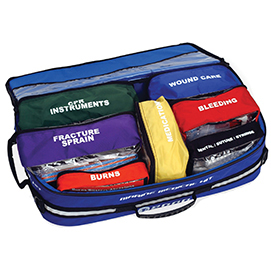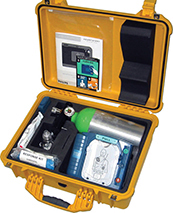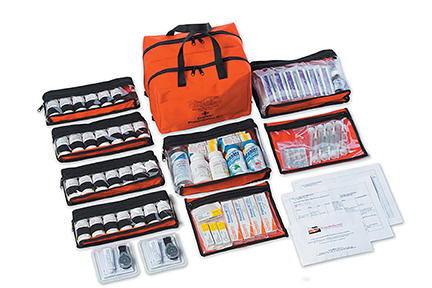Well stocked first aid and medical kits are essential for safe, healthy cruising (published May 2013)
For cruising sailors, being able to cope with medical emergencies large and small may be the most significant factor in contributing to healthy, happy cruising. Your potential exposure, due to your distance from or the availability of professional medical assistance, should be taken into account when you assemble the components of an appropriate cruising medical kit.
The contents of your medical kit should include a first aid manual, a first aid kit, prescription medications, and additional emergency medical supplies and equipment suitable for a wide range of medical situations and emergencies. You should also consider the number and age of your crew, the duration of the cruise and the time and distance you will be away from professional medical assistance. If you are sailing in remote regions, you need to be self sufficient and able to cope with burns, broken bones, allergic reactions, infections and diseases.
Two first aid manuals are widely accepted as appropriate for use by cruisers. The first is Marine Medicine, A Comprehensive Guide, written by Dr. Eric Weiss and Dr. Michael Jacobs, now in its second edition. The second is Advanced First Aid Afloat, written by Dr. Peter F. Eastman. This book, first published in 1972, has become widely accepted and is now in its fifth edition. Both of these manuals address injuries and illnesses, and include information about first aid kits, prescription medications and medical support.
A first aid kit can be assembled from scratch. This can be a worthwhile task; yet, it can be expensive and difficult as many items may not be readily available or come in the appropriate sizes or quantities desired. In addition, you should consider the many contingencies and organize and package all of the items in such a way that they are secure and readily available when needed.
There are two well designed, organized and stocked lines of first aid and medical kits developed specifically for recreational sailors. These are the Medical Sea Pak product line by Fieldtex Products, Inc. and the Marine Series Medical Kits developed by Adventure Medical Kits in consultation with Dr. Michael Jacobs, the noted sailor and marine medical authority.

These two kits do vary somewhat yet each comes in a full range of sizes, with the contents organized by category and contained in clearly marked pouches. The Medical Sea Paks are available either in a rugged nylon soft case or in a hard case, while the Marine Series are available in a foam-padded case with water-resistant zippers. The selection of a specific kit is based upon the number of persons onboard, the duration of the cruise and the anticipated time and distance away from professional medical assistance.
A final choice is to have a custom medical kit assembled for the requirements of a specific cruise. A number of vendors provide this service including Marine Medical Systems (www.marinemedical.com), World Clinic (www.worldclinic.com) and Maritime Medical Access (www.http://www.gwemed.edu/telemedicine_solutions/maritime_medical_access.aspx.
Prescription Medications
Prescription medications are a necessary component of any vessel’s medical inventory and are carried in anticipation of a wide range of illnesses and injuries that might be encountered when direct access to professional medical assistance is not an option. Developing an appropriate list of prescription medications can be done in consultation with your physician, or by referring to one of the lists found in the appendices of the manuals noted above.
An alternative for cruising sailors is the product line of Prescription Medical Kits developed by OceanMedix. These kits come in three sizes ranging from the Individual Prescription Kit designed for one person heading out on an extended adventure to the Voyager Prescription Kit designed for the vessel with a crew of up to 12 people who are setting off on an ocean voyage of up to a month.
Each kit is assembled to order with medications and supplies selected and provided in adequate quantities and then organized in a custom fabricated, rugged nylon case with internal removable pouches.

To complete the inventory of medical equipment and supplies, you might consider a few more items such as an automatic external defibrillator (AED), medical oxygen, QuikClot Advanced Clotting sponges to control extreme bleeding, a portable extraction stretcher and a neck brace.
A complete supply of over-the-counter products should not be overlooked. In addition to those items used on a regular basis, you should consider everything from sunscreen to Imodium, Milk of Magnesia, Meclizine, Q-tips and lip balm. Also, it is wise to carry a variety of motion sickness drugs as well as suppositories that can be used when a sea sick crewmember can’t keep anything down.
Prior planning, proper training and the assembling of a complete cruising medical kit will prepare you to best cope with a wide range of medical emergencies.
Denny Emory is a licensed yacht captain, holding a U.S. Coast Guard 100-ton Master’s License. He founded Emory / Yachting Services in 1996 and in 2005 he co-founded OceanMedix.com LLC. He is a member of the Ocean Cruising Club, Cruising Club of America, U.S. Sailing, Sail America, the U.S. Power Squadrons, and the Seven Seas Cruising Association.
















